Goldenrod – Growing, Foraging, Uses, & Control
This post may contain affiliate links. Read my full disclosure here.
Our land has an abundance of goldenrod plants, which provide a blast of fall color and food for pollinators. They’re also useful for food, medicine, and more. We’ll share tips for identifying the plants in the wild, growing them in the garden, and how to use them.

Identification
There are over 100 species of goldenrod in the genus Solidago. Our yard has Solidago canadensis, Canada goldenrod. Canada goldenrod is also known as common goldenrod, tall goldenrod or Aaron’s rod. It tolerates dry conditions and poor soil.
Native to North America, these plants may be considered invasive on other continents due to their vigorous growth habit. They spread through rhizomes, forming dense clumps that can create a monoculture. As a perennial, it returns year after year.
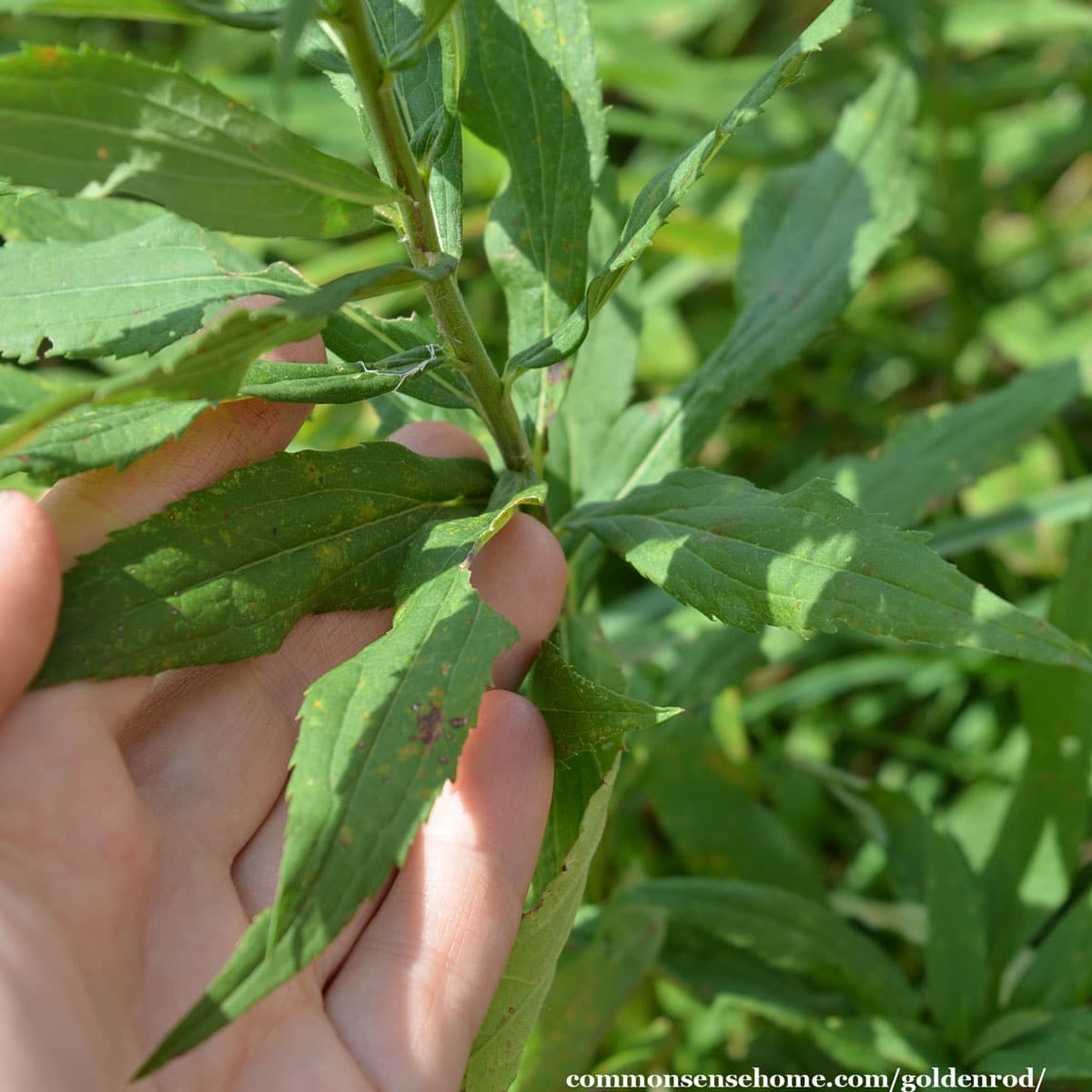
Plants in the Solidago genus have alternate lance shaped leaves and golden yellow flowers. Goldenrod blooms in summer and fall, with composite flowers. The individual flower heads form spiked flower clusters (except in varieties like flat topped goldenrod, which has a more open form).
Growing Goldenrod in the Garden
For best flowering, plant Solidago species in full sun. These plants tolerate and even thrive in poor soil, so avoid excess fertilizers. Too much fertilizer can cause tall, floppy growth. It’s fine to pinch back growing tops to encourage sturdy growth, and dead heading will prolong flowering.
To keep the plants from spreading, you may want to plant them in a large, sunken pot (like mint). Another option is to plant them where you can mow around them to keep them in check.
A third option is to choose smaller cultivars, like “Golden Fleece”, which matures at only 15 to 18 inches tall. (Wild species range between one and six feet tall, depending on the variety and conditions.) Remove spent flowers in fall to prevent self-seeding.
The plants sometimes get powdery mildew and leaf spot. Don’t overwater, and try to maintain good air circulation.
Companion Planting
Goldenrods can make good companion plants for vegetable gardening. They attract beneficial insects, such as soldier beetles and crab spiders, that eat garden pests. They also provide an abundant nectar source for bees and butterflies.
Goldenrod vs Ragweed
Although it is commonly blamed for hayfever and allergies, only 1-2% of autumn airborne pollen is from goldenrod. Ragweed is generally the real culprit.
Ragweed pollen is small and light, and readily becomes airborne. Solidago pollen is larger and sticky. People who react to Solidago species pollen generally have to be close to the plants to trigger a reaction.
Some people may have a mild skin reaction (contact dermatitis) when exposed to goldenrod. I have not. I do react from contact with ragweed.
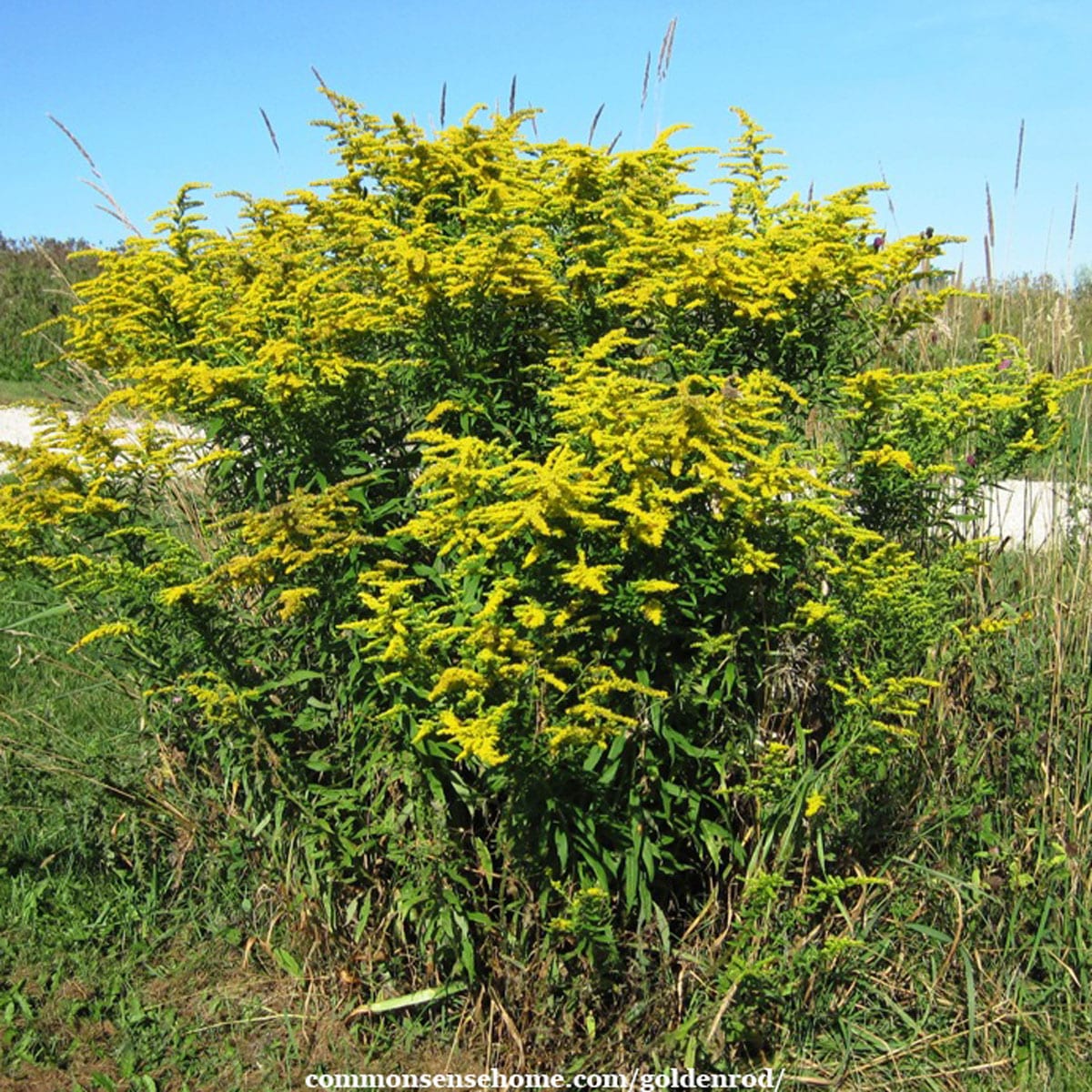
Is Goldenrod Edible?
Goldenrod is edible from root to flower. Harvest roots in early spring. Clean, dehydrate, and grind into flour, or chop finely and use in soups and stews.
Use leaves as a potherb or in herbal tea. Flowers can be eaten raw or cooked. This simple goldenrod sauce is good with fish. The bright flowers compliment the lemon and butter.
Goldenrod Sauce
- 4 Tablespoons butter
- 3 Tablespoons chopped goldenrod flowers
- 1 teaspoon lemon juice
- Salt and pepper to taste
Would you like to save this?
Melt the butter in a skillet, add the flowers, and simmer lightly for ten minutes. Add the lemon juice and blend; season with salt and pepper.
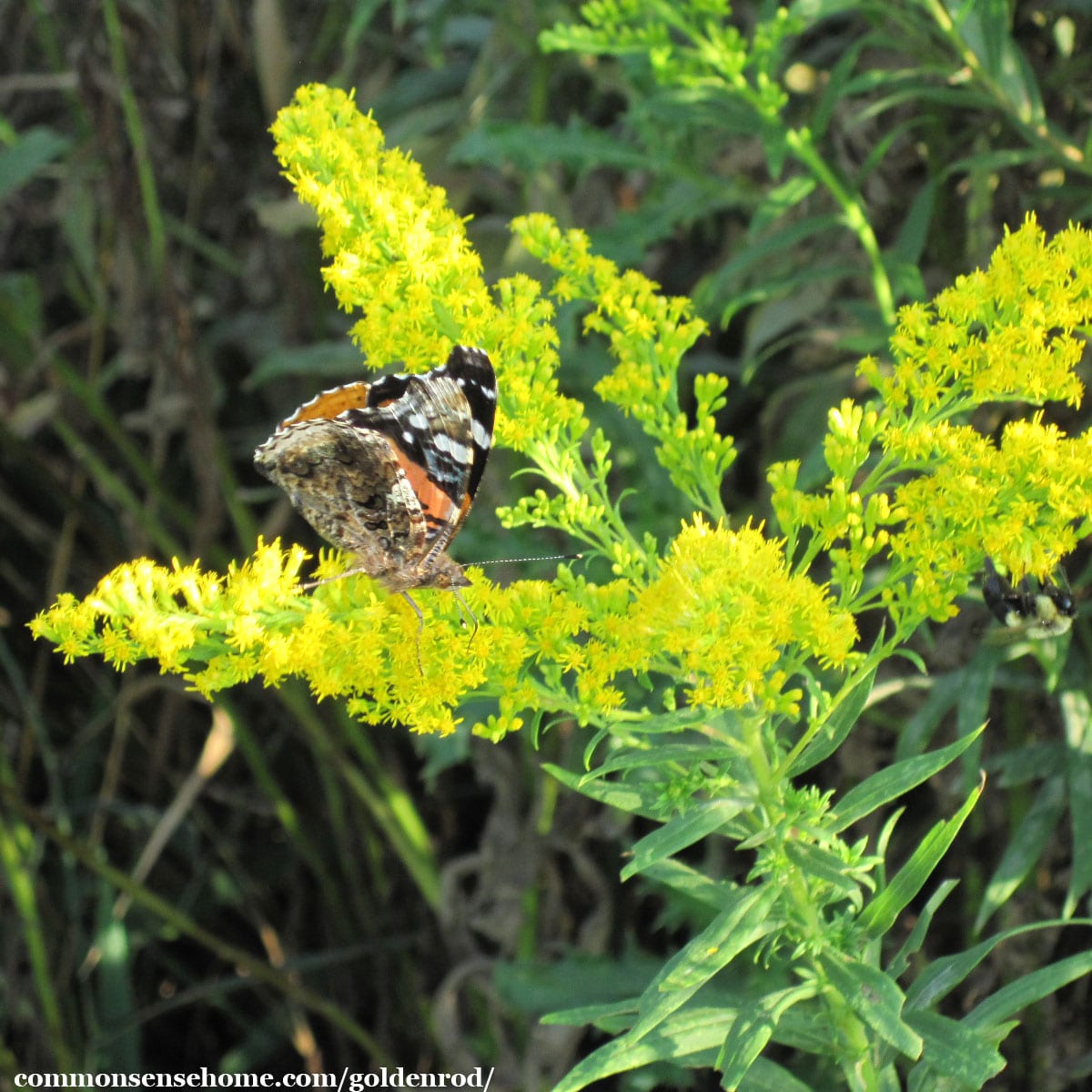
Medicinal Use
Goldenrod has a long history of medicinal use. It is astringent, diuretic, anti-microbial, anti-inflammatory, and antispasmodic. It’s used topically for wounds, burns, boils, stings, and strains. Internally, conditions treated include:
- toothache
- sore throat
- nasal congestion
- eczema
- stomach cramps
- diarrhea
- rheumatism and gout
- backache
- cancer
- yeast infections
- and more
Do not use if pregnant, and always check with your healthcare provider if you are on prescription medications.
To make a simple goldenrod tea:
Gather leaves and flower buds, roughly 2-3 tablespoons per cup. Rinse of the leaves and buds and place them in a mug. Pour a cup of boiling water over the plant material and infuse for 10 minutes.
Strain and add honey to taste, if desired. The tea has an anise-like flavor. If using dried plant material, use 2-3 teaspoons per cup.
Fabric Dying
Canada goldenrod can also be used to dye fabrics. The article “Dyeing with Goldenrod” shares the colors created using the techniques described in the book, “A Dyer’s Manual“. The range of colors shown in the photos is very interesting.
Free Fish Bait
The stems of Solidago plants are often invaded by insect larvae, causing bumps or galls in the stem. You can harvest these bumpy stems for free fishing bait. The video below explains how to identify and harvest the larvae. These replace the meal worms typically sold for ice fishing.
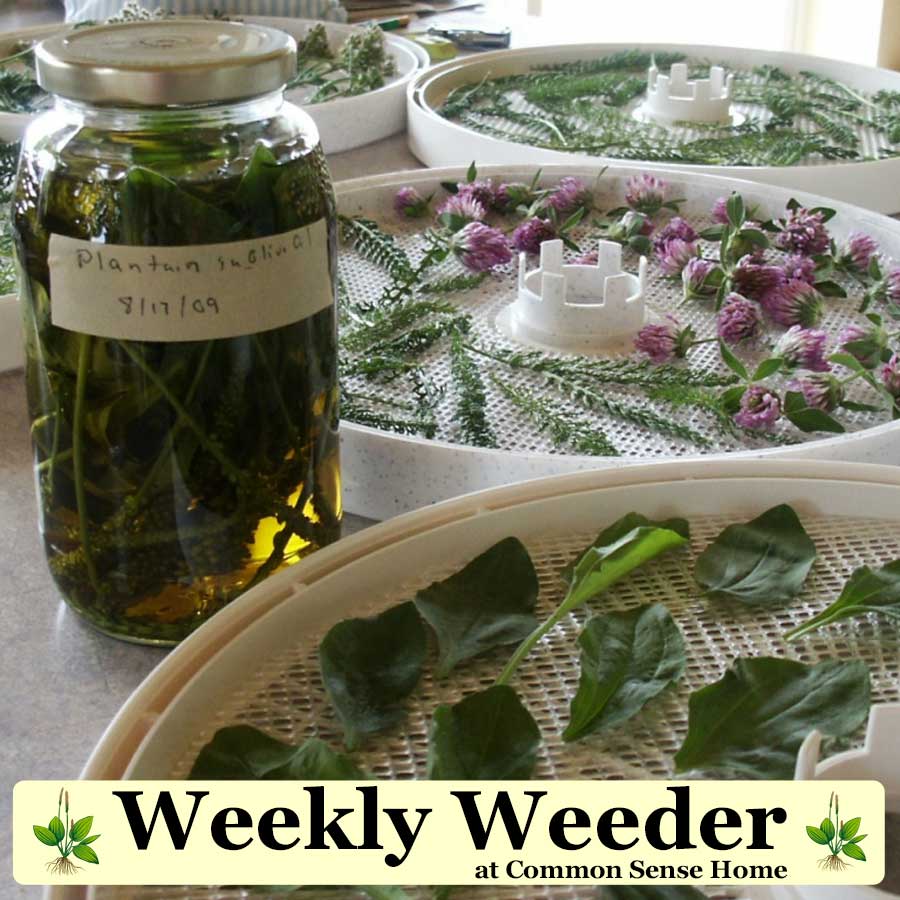
This article is part of the Weekly Weeder series, which shares how to use wild plants for food and medicine.
Other articles in the series include:
New England Aster – A Great Fall Nectar Source for Bees
Jewelweed – Traditional Remedy for Skin Ailments
Thanks for taking the time to visit, and I hope you’ll be back again soon. As always, if you’ve enjoyed the post, please pass it along. Let me know if you try out any of the uses, too.

This article is written by Laurie Neverman. Laurie was raised on a small dairy farm in northwest Wisconsin, where she gathered wildflowers from the woods and pastures. Now she and her family have 35 acres in northeast Wisconsin, where they mix intentional plantings and semi-wild areas. Every season is a new opportunity to learn more about working with wild plants.
Originally posted in 2011, last updated in 2023.

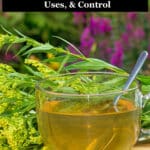

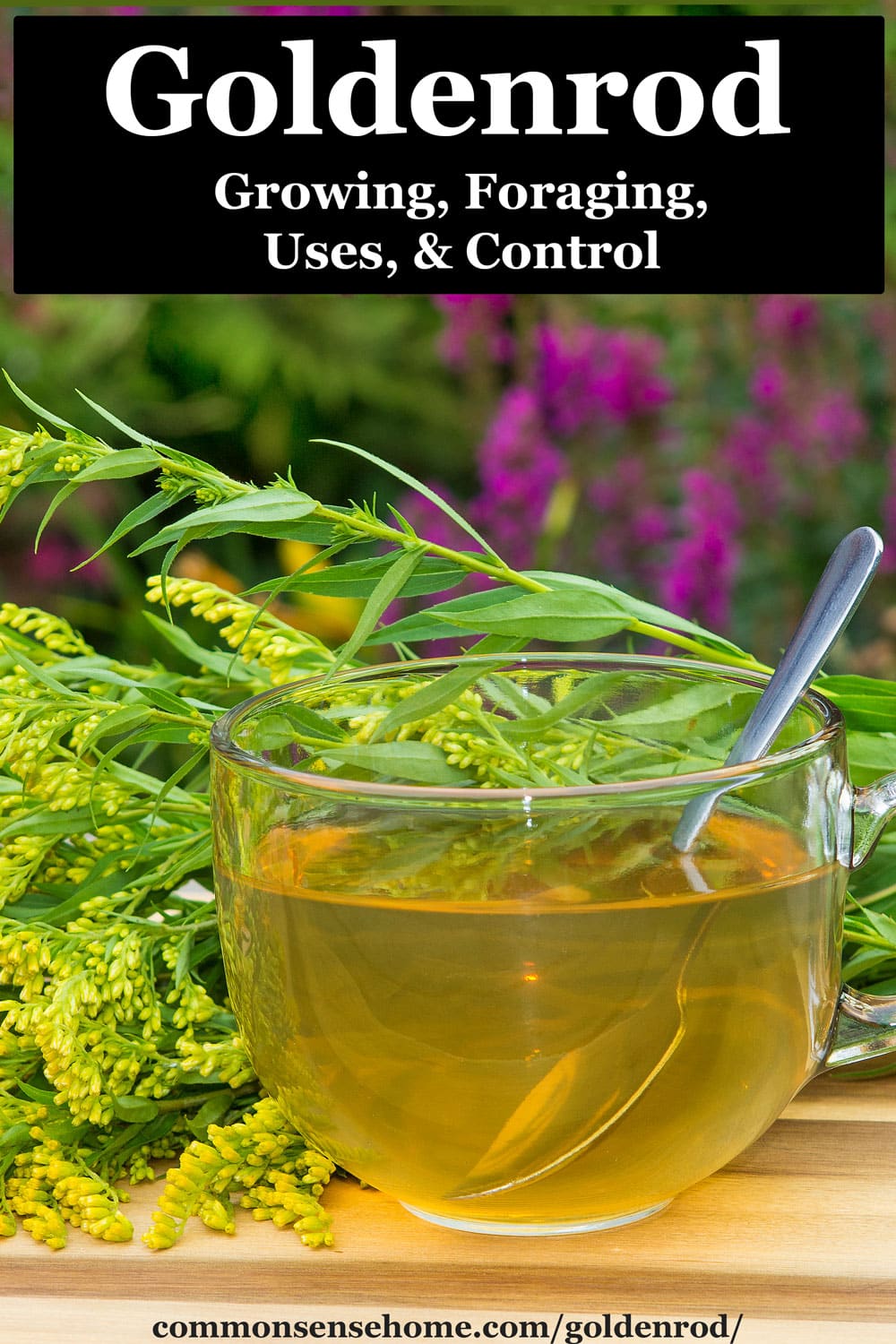



I tincture goldenrod every year and use it for seasonal allergies. I recently got swarmed by fire ants, who leave raised, red bumps with a white pustule in the middle, on me. I used the goldenrod tincture to wipe them off and they not only took away the severe burning sensation but they didn’t swell up and look terrible later. I was so impressed that I made a poultice of plantain using the tincture for the liquid and freeze dried plantain for my son who got caught by a nest of yellow jackets. He has always had a very dramatic reaction to yellow jackets, so much so that I kept an epipen around when he was a kid because we were afraid he was allergic. The stings stayed red for a couple of days but no real swelling occurred and he said it also stopped the burning sensation too. I am absolutely sold on this wonderful gift growing all over Alabama but I have never considered eating it. I’m really looking forward to trying your recipe for fish with goldenrod sauce. Thanks for a terrific article!
Wow – thanks for sharing your experience. Plantain is my first “go to” for most skin irritations, but now I want to combine the two and try it. Both plants had no problems dealing with our dry conditions this summer. We don’t have fire ants (thankfully), but we do have a ton of paper wasps. I got tagged by one a couple weeks ago from a hive that moved into the greenhouse.
Our property is even richer with Goldenrod than I had imagined! I have collected the flowers yearly to use for reducing our reaction to Ragweed and other allergens, and often add the flowers and sometimes the leaf to tea blends all Winter. I got a kick out of the goldenrod gall video, and am going to collect them to see if they can be a Winter entertainment for our hens, who yearn for bug season through the long, cold days when their grass mysteriously disappears under that nasty white stuff. I am wondering if the galls will still be viable if I collect them before dry down, since we may be deep in snow before then? I can store them where they will stay cold enough to remain dormant. A use of Goldenrod that might become pretty popular is to use it as raptor protection. A friend of ours lets Goldenrod grow rather thickly inside the area of their hen pen. The chickens don’t seem interested in Goldenrod as food, they get a little scattered shade, and they are hard to target below the plants. Transplanting a bunch of root clumps and tossing some seed heads around in the hen pen is on my list of things to do while I can still dig into our soil.
I just pulled wool out of the dyepot yesterday that I had dyed using goldenrod. I got an intense golden yellow with a nice lemon yellow on the exhaust bath. I’ll have to share the tip about the galls with my ice-fishermen.
Great post Laurie! 🙂 Thanks for sharing on Wildcrafting Wednesday.
~ Kathy
We have quite a bit of goldenrod around here, too. That reminds me of a story my neighbor told me, about how her grandmother sent them out to pick currants, and they picked individual berries and threw the stems away. Their grandmother was very upset, as it is the stems that contain the pectin to make the jelly set.
Thank-you for this post. As I write this I am viewing about 12 acres of goldenrod. I enjoy them, as beauty not a said weed. When I went to Germany to visit my Oma when I was about 10 years old she asked me to weed her garden. I pulled out all the Golden rod and got a spanking for removing her beautiful 'imported' flowers. All in the eyes of the beholder! I now enjoy them as much as she did.